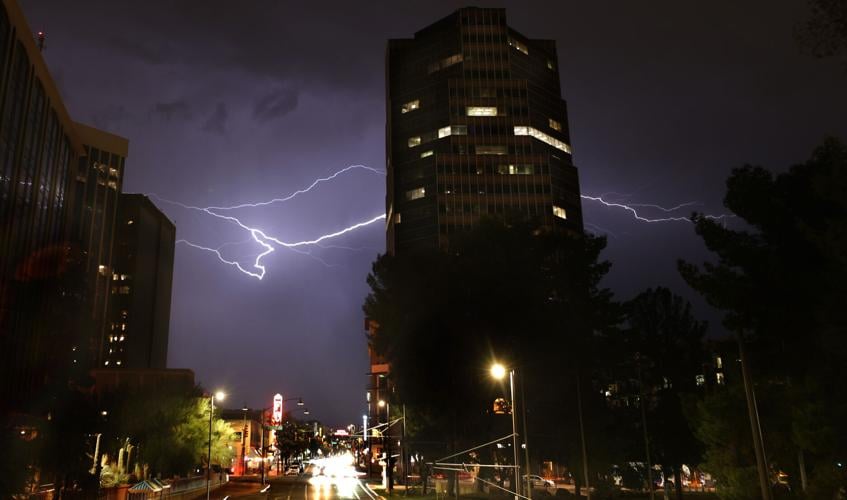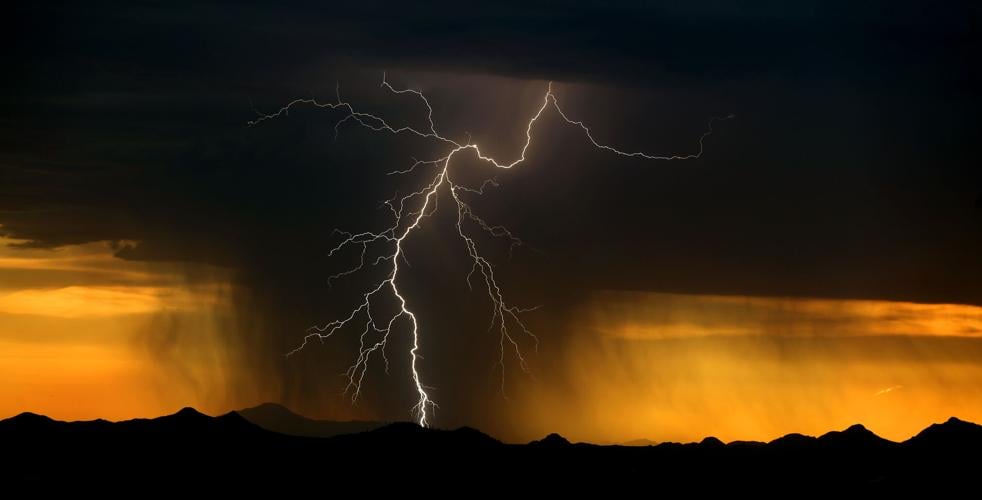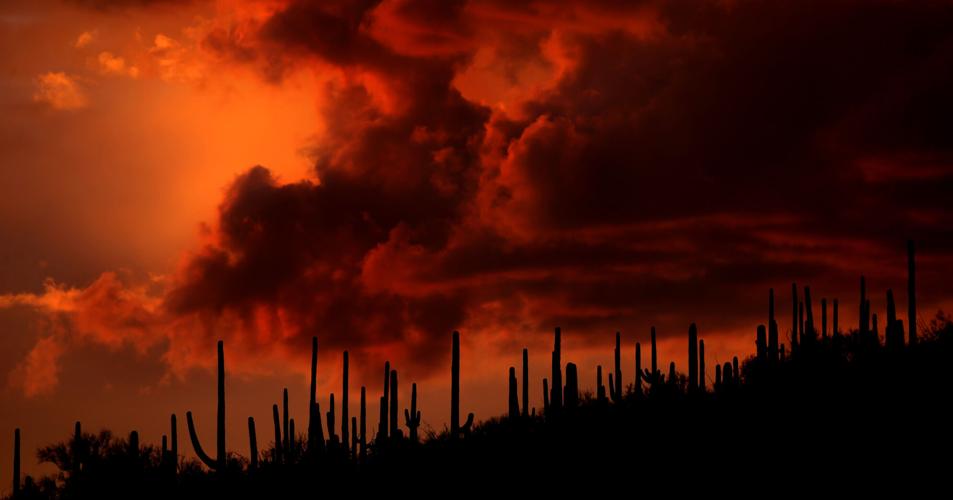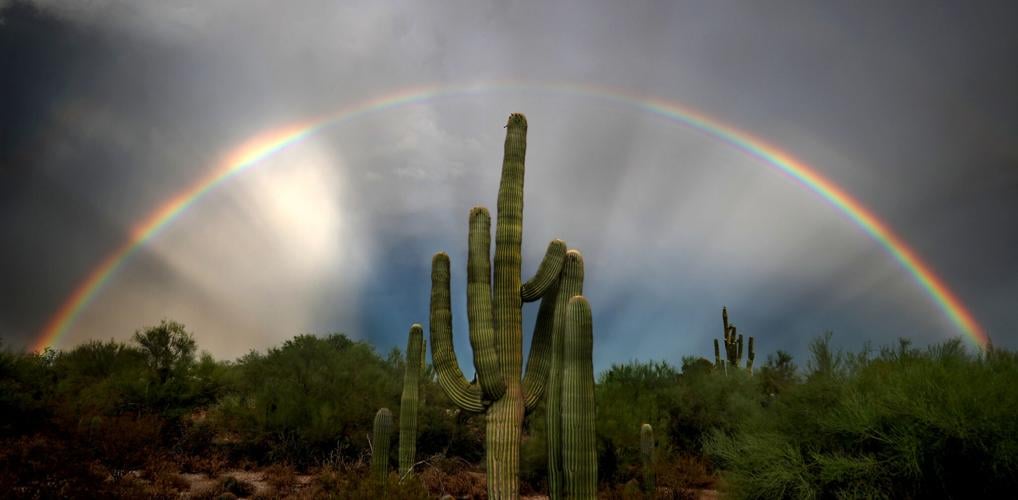We’re so close to the official start of monsoon and almost every Tucsonan has the same question:
When the heck is the rain coming?
Although the official start of monsoon is June 15, Tucson probably won’t see any storms that soon, thanks to an overall hotter and drier outlook this year, according to the National Weather Service Tucson.
Typically, the days between June 15 and July 4 are a “quiet part of the season,” according to Mike Crimmins, a professor and extension specialist at the University of Arizona’s Department of Environmental Science. He focuses on applied research and outreach on climate-related issues in the Southwest.
“It's probably going to be pretty dry. I don't think we're going to see a lot of activity (in June). I don't think we're going to see an early start to the monsoon,” he said. “So, then we look forward into July, August and September and the climate models right now are all kind of hanging together and they're all suggesting drier-than-average conditions for most of the monsoon.
“That's basically where you're starting to see the official forecast starting to lean towards a drier, average monsoon from July all the way through September. But I'm not sure it's going to be a complete collapse of the monsoon; it could be just slower than average. And that's what the forecast models are right now suggesting.”
However, Tucsonans shouldn’t bank on this year's monsoon being a total bust. Forecasting the monsoon is “probably one of the hardest jobs and it's really difficult to do,” Crimmins said.
Crimmins said that monsoon is made up of busy weeks and slow weeks and it can be challenging to forecast when and how many of those weeks will occur in the season until you’re “in the middle of that monsoon that you can even start to think about what the later part of the week or next week might look like.”
“There's just a lot of moving parts. The models are certainly picking up on something and I guess we need to take them with a grain of salt though, (because) they do struggle,” he said. “So, this is not a slam-dunk forecast for a terrible summer of dry conditions. We're really just gonna have to wait and see if they lean dry because they're kind of pulling us in that direction.
“We shouldn't be surprised if it turns out dry. But we should also keep an open mind. We might end up being surprised with a couple of good events through the summertime, especially here in Southern Arizona.”

A lightning bolt hits northwest of Gates Pass, one of the last several scattered rain cells at the tail-end of a monsoon storm that skirted south of Tucson, Ariz., July 19, 2023. The largest part of the cell slipped south of town, dropping rain and sporadic lightning in Tucson Estates and west along Ago Highway.
Tucson has seen its fair share of extreme monsoons over the last few years. The second driest monsoon on record happened in 2020 with a mere 1.62 inches of rain. The third wettest monsoon happened the next year in 2021 with 12.79 inches, followed by two below-average monsoons in 2022 and 2023 with almost five inches of rain each of those years.
For reference, the average monsoon rainfall is 5.69 inches, according to the weather service. Monsoon runs from June 15 to Sept. 30 each summer.
“Looking at last year, last year was terrible. It was really hot, very slow, quite dry,” Crimmins said. “But we did see some activity later in July and August and we saw a little bit in September, but overall, it was just quite slow. It was quite dry across much of the state. That's kind of what the models are suggesting right now.”
Stay hot, Tucson 💁♀️
Some experts are predicting that La Niña (when ocean-surface temperatures drop causing a change in winds, pressure and precipitation) could cause a drier climate in Southern Arizona, meaning a drier monsoon. Currently, the National Weather Service is predicting a 70% chance of a La Niña event this summer.
But Crimmins said the correlation between La Niña and El Niño events with monsoon isn’t super strong.
“When we have a La Niña event, it does typically make us drier. But we've had years where that's not always the case,” he said.
An element that will impact our monsoon is when a big dome of high pressure lands across the Western U.S., according to Crimmins, causing extreme heat.
“Right now, the forecast suggests it's going to be further south and it might be over top of us, or even over northern Mexico,” he said. “And so that means that all of that tropical moisture is held very far south and it's no bueno for us. It's no good. It won't help. We need the fuel for the thunderstorms, which is the moisture, and if you don't have that, you don't really have a monsoon.”
Crimmins said the current forecast for Sonora and northern Mexico is also dry, which is not ideal for a good monsoon.

A monsoon storm cloud is caught in the sunset behind a stand of saguaros on the west side of Tumamoc Hill, Tucson Ariz., August 10, 2023. The storm threw down some widely scattered rain, wind and lightning around metro Tucson.
Along with a drier monsoon, Tucsonans can expect hotter temperatures. The National Weather Service is currently predicting a 60% chance of hotter-than-normal temperatures this monsoon.
Last year, July was the hottest month ever recorded in Tucson, according to the Arizona Daily Star.
“Every day that month reached at least 100 degrees. And 29 of July's 31 days were above 105 degrees. Further, 14 days in July reached at least 110 degrees,” the Star reported last year.
With a drier monsoon, Tucson could face similar conditions again this summer.
“If we don't get the rain and the clouds coming in at the beginning of the monsoon, we're going to deal with that again,” Crimmins said. “And if that dome of high pressure, if it's not far enough north and it settles over top, that's actually what created the conditions we saw last summer. So, weak monsoon leads to very, very strong chances of these heat spells, especially the really dangerous ones. That's the thing that we should probably be most concerned about and keep an eye on for this summer.”
If you need an air-conditioned place to cool off this summer, both Pima County and the City of Tucson have a number of cooling centers. Find Pima County's here and the City of Tucson's here.

A rainbow arcs over the eastern sky behind a stand of saguaros along north Campbell Avenue, part of the scattered monsoon storm that rumbled over Tucson, Ariz., August 8, 2023.
Some may think that a monsoon refers to an individual storm, however, the word “monsoon” refers to the entire season, which is why we haven’t said “monsoon season” throughout this story. 😉
Crimmins said the word “monsoon” comes from Arabic roots and means “reversal of wind,” which is one of the three essential elements needed for a good monsoon, along with having strong weather activity in southern and central Mexico and the Gulf of California heating up, he told #ThisIsTucson in 2022.
“On average, it doesn't really come in in June. It's usually the first week of July we start to see the humidity increase, then we start to see the build-ups on the mountains, then we start to see them kind of move into the valleys,” he said. “That's kind of on average. If we're thinking about a little drier season and it's a little bit later, then you push that off about two weeks ... you start getting monsoon activity in late July.”
“That would be my best guess at this point,” he said. “And man, I would love to be wrong and that we just get into it right around July 4.”








